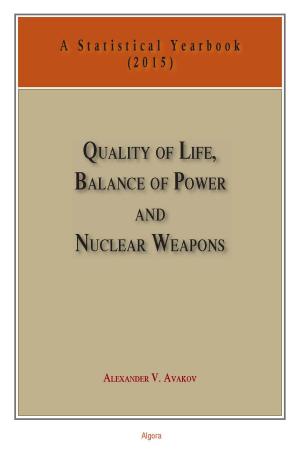Quality of Life, Balance of Power, and Nuclear Weapons (2014 Updated)
A Statistical Yearbook for Statesmen and Citizens
Nonfiction, Social & Cultural Studies, Political Science, Politics, Reference, Reference & Language, Almanacs & Trivia, Yearbooks & Annuals| Author: | Alexander V. Avakov | ISBN: | 9781628940145 |
| Publisher: | Algora Publishing | Publication: | January 5, 2015 |
| Imprint: | Algora Publishing | Language: | English |
| Author: | Alexander V. Avakov |
| ISBN: | 9781628940145 |
| Publisher: | Algora Publishing |
| Publication: | January 5, 2015 |
| Imprint: | Algora Publishing |
| Language: | English |
Who has the most nuclear assets in the Middle East? Whose power is waning, whose increasing? Updated with data from 2013, the latest available, these tables of economic, demographic and military indicators establish the pecking order for 236 countries, with estimates of all nuclear arsenals including rarely published data on non-signatory nations. The author also sums up what statistics in the developed world show in relation to the efficiency of private health insurance versus a 'public option' and whether it is true that 'taxation stifles the economy.'
This statistical annual presents fundamental data comparing measures of (1) Quality of Life, (2) Balance of Power, and (3) Developed Market Economies since 1960. It is far more complete other statistical publications. Section 2 includes data about nuclear delivery systems and the number of nuclear warheads of all nuclear powers, including estimates of the Israeli nuclear arsenal which usually do not appear in the press.
Official estimates of Russian military expenditures distributed by U.S. and British intelligence communities are methodologically flawed, claiming to show military expenditures of other countries at market exchange rates while they apparently cite Russian military expense figures at purchasing power parities, thus distorting the comparison. Such deceptive practices of the Anglo-American intelligence services are counter-balanced by presenting two different tables, showing military expenditures estimates both at market exchange rates and by purchasing power parities.
Members of the U.S. Congress and others who care about the foundations of power politics in the nuclear age will find facts that speak for themselves in this novel yearbook.
Who has the most nuclear assets in the Middle East? Whose power is waning, whose increasing? Updated with data from 2013, the latest available, these tables of economic, demographic and military indicators establish the pecking order for 236 countries, with estimates of all nuclear arsenals including rarely published data on non-signatory nations. The author also sums up what statistics in the developed world show in relation to the efficiency of private health insurance versus a 'public option' and whether it is true that 'taxation stifles the economy.'
This statistical annual presents fundamental data comparing measures of (1) Quality of Life, (2) Balance of Power, and (3) Developed Market Economies since 1960. It is far more complete other statistical publications. Section 2 includes data about nuclear delivery systems and the number of nuclear warheads of all nuclear powers, including estimates of the Israeli nuclear arsenal which usually do not appear in the press.
Official estimates of Russian military expenditures distributed by U.S. and British intelligence communities are methodologically flawed, claiming to show military expenditures of other countries at market exchange rates while they apparently cite Russian military expense figures at purchasing power parities, thus distorting the comparison. Such deceptive practices of the Anglo-American intelligence services are counter-balanced by presenting two different tables, showing military expenditures estimates both at market exchange rates and by purchasing power parities.
Members of the U.S. Congress and others who care about the foundations of power politics in the nuclear age will find facts that speak for themselves in this novel yearbook.















